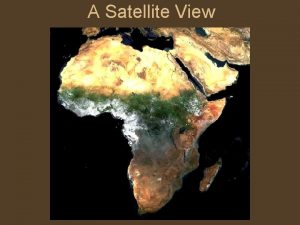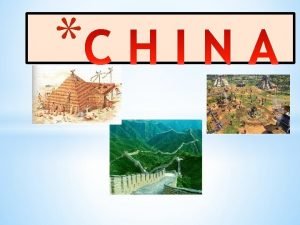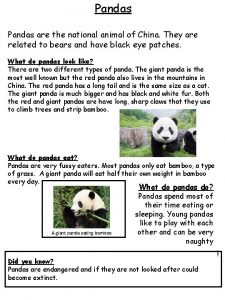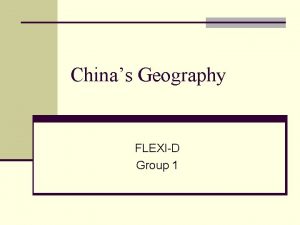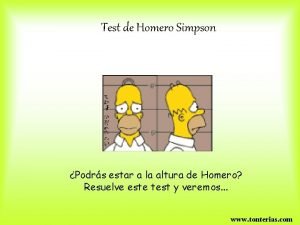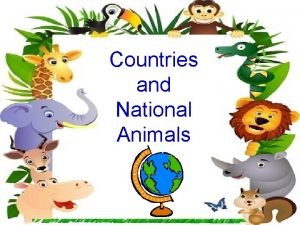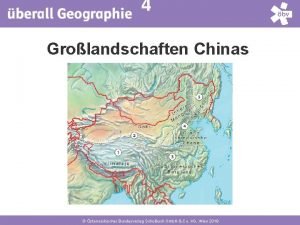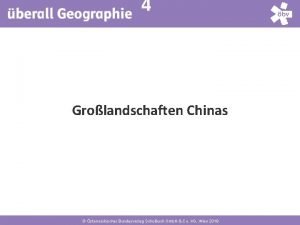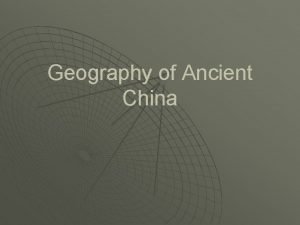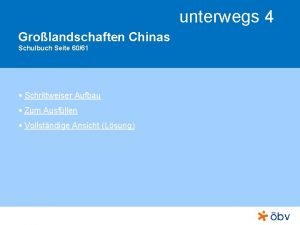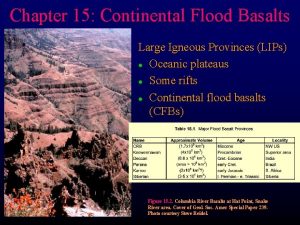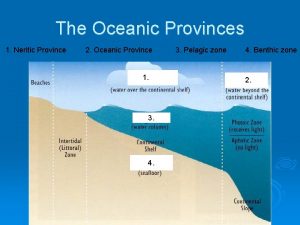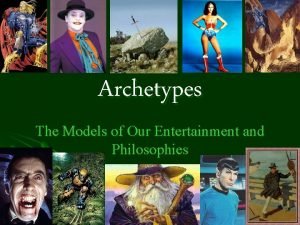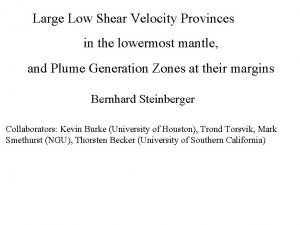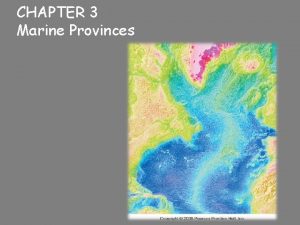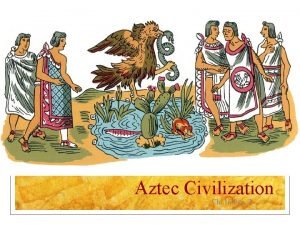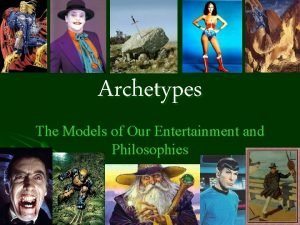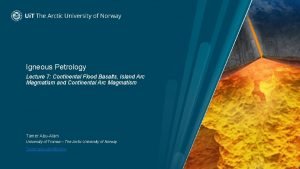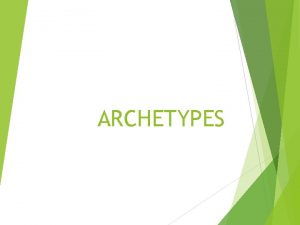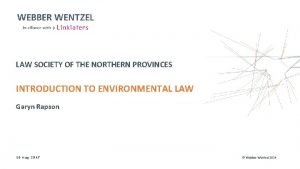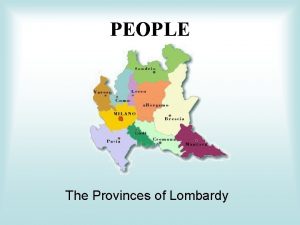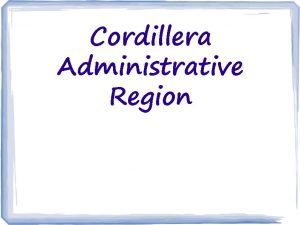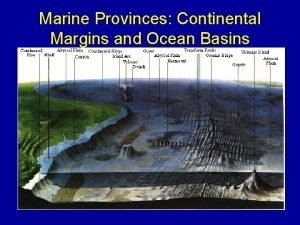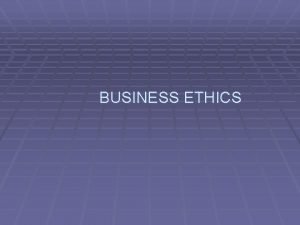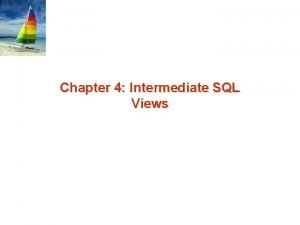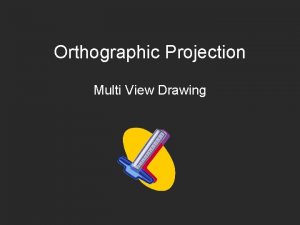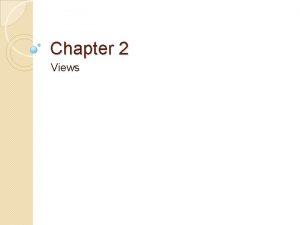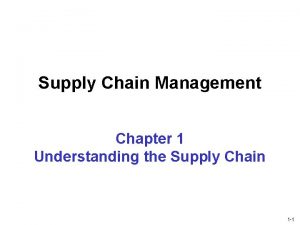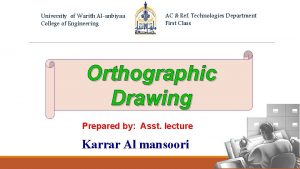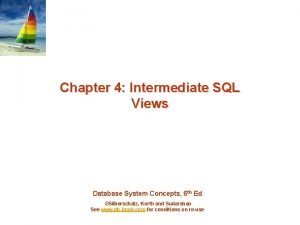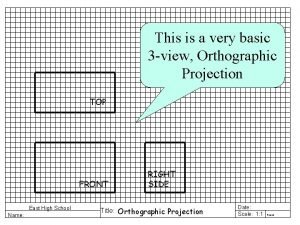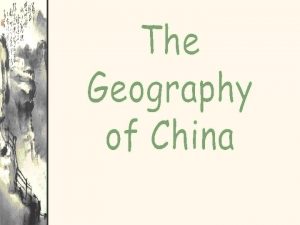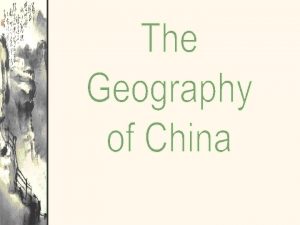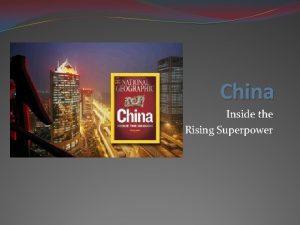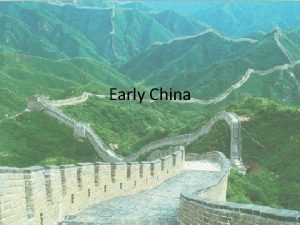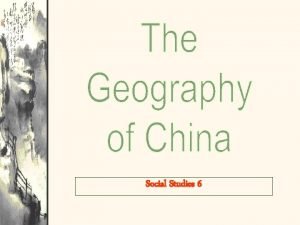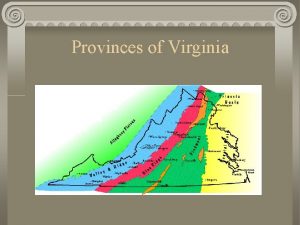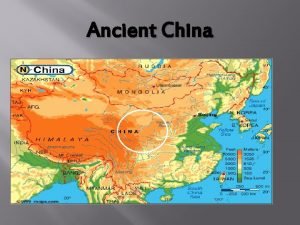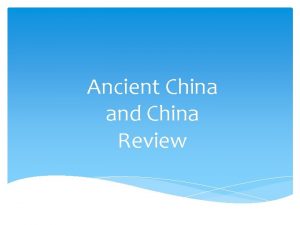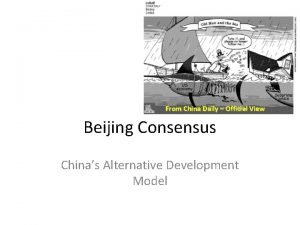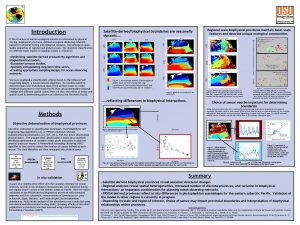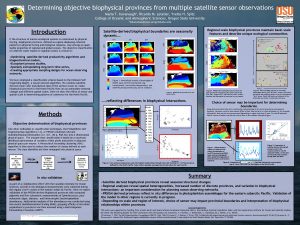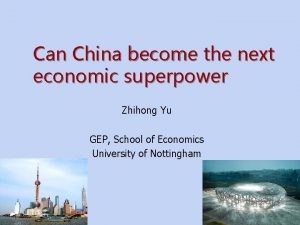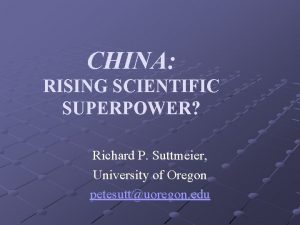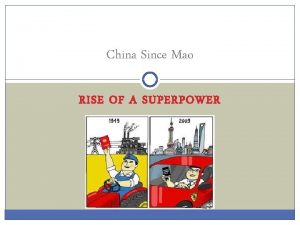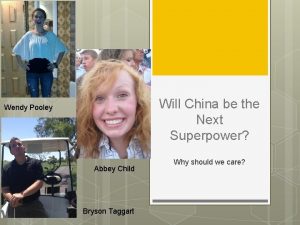Satellite View of China Chinas Provinces ChinaAsias Superpower

















































- Slides: 49



Satellite View of China

China’s Provinces

China—Asia’s Superpower

China vs. the U. S. in Size China United States

Comparing China & the U. S. Size Main physical barrier Main River Population Connectivity problems China United States 3. 7 million square miles Himalayas 3. 6 million square miles Rockies Yangtze / East - West East Coast North - South Mississippi / North – South East Coast East - West

Pacific “Rim of Fire”

Bodies of Water Am ur Riv er Sea of Japan e River H g n a u H Yellow Sea River Yangtze Xi Riv er Pacific Ocean South China Sea

China’s Climate Zones

Precipitation in China

Arable Land

“Brown” China vs. “Green” China t an n i Pasture and Oasis at e h om D W Rice ant n i om D Double-crop rice

China as % of World Population

The Population of China thousands

The Polluted Yellow River! VOCABULARY Loess

The Yellow River n n n Huang He 2, 920 Miles: Tibet to the Yellow Sea Deposits (loess) fertile, light colored soil – No need for metal tools for generous harvests n Periodic flooding: “China’s sorrow”

Prehistoric Society: Yangshao n n n 5000 -3000 BCE Middle region of the Yellow River valley Banpo Village – Found in 1952 n n n Painted pottery Bone tools Population increase necessitated organized authority

The Earliest Dynasties n Xia – C. 2200 BCE – Legend -> Founded by Yu – Organized through village network – Hereditary monarchy – Flood control – Rise of cities, bureaucracy, & bronze weapons

Bronze Age Empires

Shang Dynasty - 1766 -1122 BCE n Bronze metallurgy – State monopoly of copper & tin ores. n n Horse-drawn chariots, other wheeled vehicles Large armies – 3, 000 – 13, 000 strong Demand of agricultural tribute Political organization: network of fortified cities, loyal to center – 1000 cities – Capital moved six times • Impressive architecture at Ao (33 x 66 wall), Yin n Other regional kingdoms coexist: Sanxingdui

Shang Dynasty Burial Practices n n Hierarchical social structure Live burials alongside deceased member of ruling class – Sacrificial victims, mostly slaves – Wives, servants, friends, hunting companions – Later replaced by statuary, often monumental

Shang Religion n n Animism – The belief that spirits inhabit everything. Ancestor Worship Shang Di – A god who controlled the forces of nature Oracle Bones

Oracle Bones

Oracle Bones and Early Chinese Writing n Used for communicating with spirit world, determining future – Question written on animal bones, turtle shells – Then heated over fire, cracks examined for omens n n Early archaeological evidence of Chinese writing Evolution of Chinese script – Pictograph to ideograph

Oracle Bone from Shang Dynasty

The Evolution of Chinese Writing During Pictographs Semantic-Phonetics

Zhou Literature n n The reflections of Confucius Book of Changes – Manual for divination n n Book of History (Zhou propaganda) Book of Etiquette (Book of Rites) Book of Songs (…of Poetry or …of Odes) Little survived – Often written on perishable bamboo strips – Many destroyed by Emperor of Qin dynasty in 221 BCE

Axe Scepter – 1100 BCE - Jade Ceremonial Dagger – 1028 BCE

Shang Urn

Shang Bronzes

Ritual Wine Vessel – Bronze, 13 c BCE

Western Zhou: 1027 -771 BCE

Zhou Dynasty, 1122 -256 BCE n n No law codes: rule by decree – “Mandate of Heaven” Aggregation of villages opposed to Shang leadership – Decentralization of authority – Lacked organization efficiency Development of cheap iron weaponry ends Shang monopoly on Bronze Early money economy

Zhou Coins - Bronze

“T’ian Ming” The Mandate of Heaven 1. The leader must lead by ability and virtue. 2. The dynasty's leadership must be justified by succeeding generations. 3. The mandate could be revoked by negligence and abuse; the will of the people was important.

Start here A new dynasty comes to power. “Son of Heaven” The emperor reforms the govt. & makes it more efficient. Emperor is defeated !! Rebel bands find strong leader who unites them. Attack the emperor. Poor lose respect for govt. They join rebels & attack landlords. The Dynastic Cycle Droughts, floods, famines occur. Lives of common people improved; taxes reduced; farming encouraged. Problems begin (extensive wars, invasions, etc. ) Taxes increase; men forced to work for army. Farming neglected. Govt. increases spending; corruption.

Heaven, unpitying, has sent down ruin on the Shang. The Shang has lost the Mandate, and we, the Zhou have received it. I dare not say that our fortune would continue to prosper, even though I believe that heaven favors those who are sincere in their intentions. I dare not say, either that it would end in certain disaster… The Mandate of Heaven is not easy to gain. It will be lost when men fail to live up to the reverent and illustrious virtues of our forefathers. Duke of Shao, quoted in The Chinese Heritage

Early Ideology n n Yin and Yang Yin: female, dark, weak, wet, passive Yang: male, bright, strong, dry, active Balance of opposites

Zhou Contributions n n Aristocrats Feudalism – Kings > Local Lords > Peasants • Feudal Lords Gain Power n n n Iron Age The First Bound Books Astronomers Study Planets & Eclipses

Silk Worms

Decline of the Zhou Dynasty n Decentralized leadership style allows for building of regional powers – Increasing local independence, refusal to pay Zhou taxes n n n Iron metallurgy allows for widespread creation of weaponry Northern invaders weaken Zhou dynasty, beginning 8 th c BCE Internal dissention: the Period of the Warring States (403 -221 BCE)

China during the Period of the Warring States, 403 -221 BCE

“Chung Kuo” (The “Middle Kingdom”)

Social Order n Ruling classes great advantage – Palatial compounds, luxurious lifestyle – Supported by agricultural surplus, tax revenues – Defended by monopoly on bronze weaponry – Hereditary privilege n n Support class of artisans, craftsmen Evidence of long-distance trade, merchant class Large class of semi servile peasants Slave class (mostly POW’s)

Family and Patriarchy n Devotion to family, ancestor veneration – Family responsible for socialization of children and preservation of cultural traditions n Connection of spirit world to physical world – Ritual sacrifices n n n Father ritual head of family rites (rather than priests) Earlier prominence of individual female leaders fades in later Shang, Zhou dynasties Genealogy

Nomadic Peoples of Central Asia n n Despite geographic boundaries, long distance trade exists while limited in scope Steppe nomads – Poor lands for cultivation, extensive herding activities – Horses domesticated c. 4000 BCE, bronze metallurgy in 2900 BCE – Organized under charismatic warrior chiefs n n n Extensive trade with sedentary cultures in China Tensions: frequent raiding Ethnocentrism/Xenophobia

The Yangtze River

Southern Expansion of Chinese Society n Yangzi Valley – Peaceful flooding – Yangzi river: Chang Jiang, “long river” – Excellent for rice cultivation – Irrigation system developed n The State of Chu – Autonomous, challenged Zhou dynasty – Culture heavily influenced by Chinese
 Superpower poem
Superpower poem Satellite view of africa
Satellite view of africa View cube satellite
View cube satellite Satellite view of antarctica
Satellite view of antarctica Satellite view of antarctica
Satellite view of antarctica Regiones chinas
Regiones chinas Juego damas reglas
Juego damas reglas Chinas physical features
Chinas physical features National animal china
National animal china Whats chinas longest river
Whats chinas longest river Chinas dynastys
Chinas dynastys Tomografia homero simpson
Tomografia homero simpson Greece's national animal
Greece's national animal überall geographie 4
überall geographie 4 China großlandschaften
China großlandschaften Taklamakan desert map
Taklamakan desert map China großlandschaften lösungen
China großlandschaften lösungen Kappa psi provinces
Kappa psi provinces Flood basalt provinces diagram
Flood basalt provinces diagram Neritic province and oceanic province
Neritic province and oceanic province Canadian shield
Canadian shield Unfaithful wife archetype examples disney
Unfaithful wife archetype examples disney Large low shear velocity provinces
Large low shear velocity provinces Precision depth recorder
Precision depth recorder The river archetype examples
The river archetype examples Virginia physiographic provinces
Virginia physiographic provinces Conquered provinces resented aztec rule because the aztecs
Conquered provinces resented aztec rule because the aztecs Unfaithful wife archetype examples disney
Unfaithful wife archetype examples disney Flood basalts diagram
Flood basalts diagram The evil figure with the ultimately good heart
The evil figure with the ultimately good heart Great plains of canada
Great plains of canada Law society of the northern provinces
Law society of the northern provinces English speaking provinces in canada
English speaking provinces in canada Provinces of lombardy
Provinces of lombardy Regional center of cordillera administrative region
Regional center of cordillera administrative region Active and passive continental margins
Active and passive continental margins Integration view of ethics
Integration view of ethics What is an end view
What is an end view For the view create view instructor_info as
For the view create view instructor_info as Ap view vs pa view
Ap view vs pa view Section
Section Multi view drawings
Multi view drawings Isometric to orthographic
Isometric to orthographic Simple view and complex view
Simple view and complex view Scm cycle view
Scm cycle view Full section vs half section
Full section vs half section Front view top view
Front view top view For the view create view instructor_info as
For the view create view instructor_info as Simple view and complex view
Simple view and complex view The top view is directly above the front view
The top view is directly above the front view

